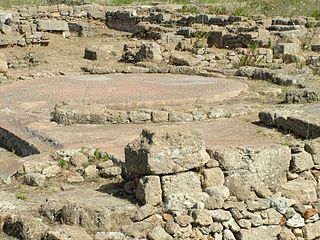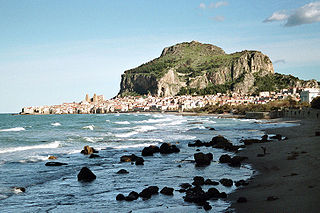Related Research Articles

Milazzo is a town (comune) in the Metropolitan City of Messina, Sicily, southern Italy; it is the largest commune in the Metropolitan City after Messina and Barcellona Pozzo di Gotto. The town has a population of around 31,500 inhabitants.

Reggio di Calabria, commonly known as Reggio Calabria(

Tindari, ancient Tyndaris or Tyndarion, is a small town, frazione in the comune of Patti and a Latin Catholic titular see.

The Strait of Messina is a narrow strait between the eastern tip of Sicily and the western tip of Calabria in the south of Italy. It connects the Tyrrhenian Sea to the north with the Ionian Sea to the south, within the central Mediterranean. At its narrowest point, between Torre Faro and Villa San Giovanni, it is 3.1 km (1.9 mi) wide. At the town of Messina it is 5.1 km (3.2 mi) wide. The strait's maximum depth is about 250 m (820 ft).

Taormina is a comune (municipality) in the Metropolitan City of Messina, on the east coast of the island of Sicily, Italy. Taormina has been a tourist destination since the 19th century. Its beaches on the Ionian sea, including that of Isola Bella, are accessible via an aerial tramway built in 1992, and via highways from Messina in the north and Catania in the south. On 26–27 May 2017 Taormina hosted the 43rd G7 summit.

Megara Hyblaea – perhaps identical with Hybla Major – is an ancient Greek colony in Sicily, situated near Augusta on the east coast, 20 kilometres (12 mi) north-northwest of Syracuse, Italy, on the deep bay formed by the Xiphonian promontory. There were at least three cities named "Hybla" in ancient accounts of Sicily which are often confounded with each other, and among which it is sometimes very difficult to distinguish.
The Bruttians were an ancient Italic tribe of Lucanian descent. They inhabited the southern extremity of Italy, from the frontiers of Lucania to the Sicilian Straits and the promontory of Leucopetra. This roughly corresponds to the modern region of Calabria.

Licata, formerly also Alicata, is a city and comune located on the south coast of Sicily, at the mouth of the Salso River, about midway between Agrigento and Gela. It is a major seaport developed at the turn of the twentieth century, shipping sulphur, the refining of which has made Licata the largest European exporting centre, and asphalt, and at times shipping cheese.

Motya was an ancient and powerful city on San Pantaleo Island off the west coast of Sicily, in the Stagnone Lagoon between Drepanum and Lilybaeum. It is within the present-day commune of Marsala, Italy.

Halaesa, also known as Halaesa Archonidea and also spelled Alaesa or Halesa was an ancient city of Sicily, situated near the north coast of the island, between Cephaloedium and Calacte.

Naxos or Naxus was an ancient Greek city, presently situated in modern Giardini Naxos near Taormina on the east coast of Sicily.

Scilla is a town and comune in Calabria, Italy, administratively part of the Metropolitan City of Reggio Calabria. It is the traditional site of the sea monster Scylla of Greek mythology.

Scylletium or Scolacium was an ancient seaside city in Calabria, southern Italy. Its ruins can be found at the frazione of Roccelletta, in the comune of Borgia, near Catanzaro, facing the Gulf of Squillace.
Punta di Pellaro is the extreme southwestern point of mainland Italy, in the region of Calabria, looking towards the east coast of Sicily, at 38°01′N15°38′E.

Aetna, was an ancient city of Sicily, situated at the foot of the mountain of the same name, on its southern declivity. It was originally a Sicelian city, and was called Inessa or Inessum.
Agathyrnum or Agathyrna, was an ancient city on the north coast of Sicily between Tyndaris and Calacte. It was supposed to have derived its name from Agathyrnus, a son of Aeolus, who is said to have founded the city. But though it may be inferred from this story that it was an ancient city, and probably of Spartan origin, we find no mention of it in history until after Sicily became a Roman province. During the Second Punic War it became the headquarters of a band of robbers and freebooters, who extended their ravages over the neighboring country, but were reduced by the consul Laevinus in 210 BCE, who transported 4000 of them to Rhegium. It very probably was deprived on this occasion of the municipal rights conceded to most of the Sicilian towns, which may account for our finding no notice of it in Cicero, though it is mentioned by Strabo among the few cities still subsisting on the north coast of Sicily, as well as afterwards by Pliny, Ptolemy and the Itineraries.

Eryx was an ancient city and a mountain in the west of Sicily, about 10 km from Drepana, and 3 km from the sea-coast. It was located at the site of modern Erice.

Faro Point is the northeastern promontory of Sicily situated in Messina province, northeast of the city of Messina.

Capo Passero or Cape Passaro is a celebrated promontory of Sicily, forming the extreme southeastern point of the whole island, and one of the three promontories which were supposed to have given to it the name of "Trinacria."

Cefalù, the classical Cephaloedium (Κεφαλοίδιον), is a city and comune in the Italian Metropolitan City of Palermo, located on the Tyrrhenian coast of Sicily about 70 km (43 mi) east of the provincial capital and 185 km (115 mi) west of Messina. The town, with its population of just under 14,000, is one of the major tourist attractions in the region. Despite its size, every year it attracts millions of tourists from all parts of Sicily and also, from all over Italy and Europe.
References
- ↑ vi. p. 257.
- ↑ Homer The Odyssey xii. 73, etc., 235, etc.
- ↑ Seneca Ep. 79; William Henry Smyth, Sicily, p. 107.
- ↑ Strabo vi. p. 257.
- ↑ Pliny iii. 5. s. 10; Pomponius Mela ii. 4. § 8; Ptolemy iii. 1. § 9.; Stephanus of Byzantium s. v.)
- ↑ ancient: Caenys Prom.
- ↑ Smyth, Sicily, p. 108.

|title=(help)